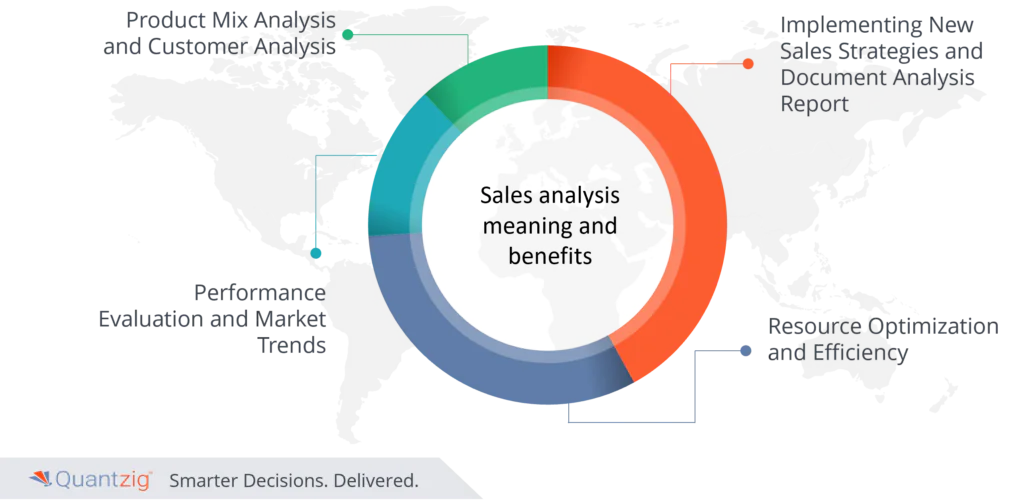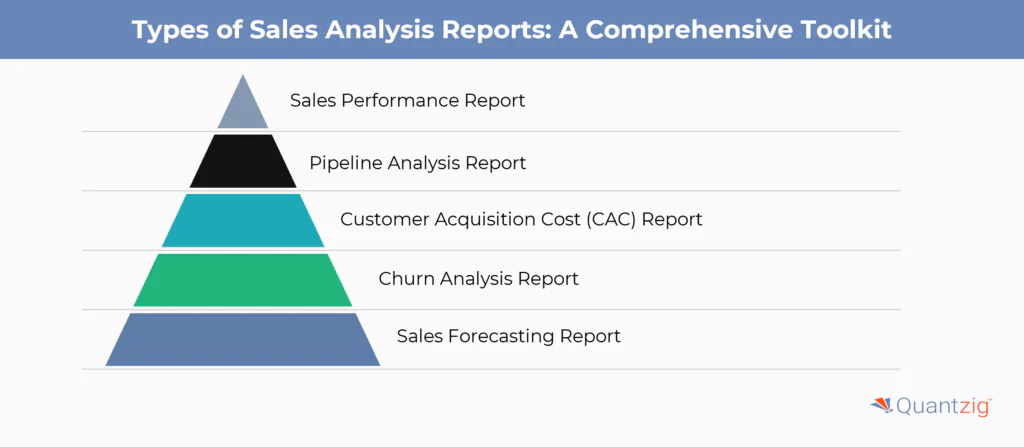Written By: Associate Vice President, Analytics and Data Strategy, Quantzig.
Table of Contents
Introduction to Advanced Sales Analytics
In the fast-paced world of sales metrics management, staying ahead requires more than intuition—it demands actionable insights derived from comprehensive sales analysis reports. These sales data analytics reports with charts and graphs (full of statistics) and based on templates serve as invaluable tools for sales managers, offering a detailed examination of performance metrics, trends, and areas for improvement. This blog explores the top benefits of a sales analysis/statistical analysis report, shedding light on its importance and the key types of reports that empower sales managers to make informed decisions and drive success.
Book a demo to experience the meaningful insights we derive from data through our analytical tools and platform capabilities. Schedule a demo today!
Request a Free DemoWhat is Sales Data Analysis?
How big a role does sales analysis play in your present company? Most think of lively telephonic conversations, long lunches, and game-time when it comes to product sales. But with the rise of analytics, the notion of sales analysis is witnessing a paradigm shift. Studies have shown that the companies that invest in sales analysis reports can boost their returns by more than 15-20%.
Unfortunately, the sales analysis manager in any company will always have too much analyze data, and they often struggle when it comes to developing strategies to boost sales and profits. It is in this context that the importance of a sales analysis report can be realized.
A sales analyst analyze sales data analysis steps report empowers businesses to analyze sales by breaking it into comprehensible pieces to examine improvement areas. From providing in-depth insights using data-driven sales strategies into product performance, prospects behavior, and sales teams effectiveness to aiding in forecasting, pricing strategies, and inventory management, the Sales Analysis Report equips sales managers with the knowledge needed to drive success. By harnessing the power of data and analytics, sales managers can make informed decisions, optimize resources, and stay ahead in a competitive market. Join us in uncovering the essential advantages of this invaluable tool.
What is the Importance of Sales Analysis?
In its most basic form, a sales data analysis showcases trends that occur in a company’s sales volume over time. It also shows sales managers whether sales are increasing or declining so that they can determine the best course of action to mitigate losses.
- Firstly, it provides a comprehensive view of a company’s sales performance, offering valuable insights into what products or services are selling well and which ones may need improvement. This data-driven approach allows for informed decision-making, enabling businesses to optimize their product offerings, pricing strategies, and inventory management.
- Secondly, a Sales Analysis Report helps in forecasting future sales, allowing businesses to allocate resources effectively, manage inventory efficiently, and plan for growth. It helps in avoiding overstock or stockouts, optimizing cash flow, and reducing financial risks.
- Thirdly, this cross-sell analytics in sales reports aids in evaluating the performance of the sales team, identifying top performers, and pinpointing areas that may require additional training or support.
In essence, a Sales Analysis Report is a vital tool for enhancing sales, improving overall business profitability, and ensuring a competitive edge in the market. It empowers businesses to adapt to changing market conditions and make data-driven decisions that lead to sustainable growth.
Sales analytics software meaning and benefits:
Benefit 1: Product Mix Analysis
The real importance of a sales data analysis report can be realized while doing a comprehensive product mix analysis. The Product Analysis Report is a powerful tool for gaining a comprehensive understanding of your products, services, and sales performance. By providing up-to-date sales analysis data, it equips businesses with valuable insights. This report helps you identify top-selling products, assess demand fluctuations, and optimize your product offerings. It empowers data-driven decision-making, enabling you to make informed choices regarding product development, pricing strategies, and inventory management, ultimately enhancing your business’s overall performance.
Benefit 2: Customer Analysis
Acquiring customers through CRM software is an expensive affair, especially for new companies with huge deal-sizes and high KPIs and increasing competitors since it involves spending on marketing analytics initiatives and sales dashboard/analytics dashboard consultations. By utilizing a sales analysis report, companies can identify the distinct needs of customers and segmentation and address them with targeted solutions. The data generated from a sales analysis report will help sales managers to segregate customers into particular tiers and analyze purchasing behavior at an individual level.
Benefit 3: Implementing New Sales Strategies
Apart from the benefits mentioned above, monthly sales analysis reports can also help companies to identify and implement strategies for optimal performance. In some instances, something like sales analysis can reveal that a particular product’s demand and performance is declining. This would give the scope to offer discounts and accurate inventory. A sales data analysis report from IoT can also help track whether the findings are on par to achieve the organizational objectives. The insights gleaned from such reports can also help salespeople to recommend add-ons or upgrades based on the customer profile.
Benefit 4: Document Analysis Report
The Document Analysis Report is designed to streamline your invoicing process. It facilitates batch invoicing, which accelerates the generation of invoices, reduces manual work, and minimizes errors. Additionally, it offers a convenient way to access and review transaction history on a dashboard, simplifying financial record-keeping and reconciliation. This report enhances efficiency in financial operations, helping you save time and resources while maintaining accurate financial records.
Benefit 5: Performance Evaluation and Goal Setting
Sales performance is a metric of paramount importance, and sales analysis reports play a pivotal role in evaluating and setting performance benchmarks. By assessing individual and team performance against predefined targets, managers gain insights into strengths, weaknesses, and areas for improvement. This data-driven approach not only facilitates fair performance evaluations but also informs the process of setting realistic and achievable sales goals.
Example: A sales manager, armed with a detailed sales performance report, can identify top-performing sales representatives and recognize areas where additional training or support is required. This fosters a culture of continuous improvement and ensures that goals are set in alignment with the capabilities and potential of the sales team.
Benefit 6: Market Trends and Adaptability
In the ever-evolving landscape of sales, staying attuned to market trends is imperative. Sales analysis reports provide a lens through which sales managers can scrutinize market dynamics, industry trends, and customer preferences. Armed with information from sales pipeline analytics, managers can proactively adapt their sales strategies to align with changing market conditions, ensuring that their approach remains relevant and resonates with the target audience.
Example: A sales manager, through trend analysis, identifies a shift in customer preferences towards online purchasing. In response, the sales strategy is adapted to enhance the online shopping experience, implement targeted digital marketing campaigns, and optimize e-commerce channels.
Benefit 7: Resource Optimization and Efficiency
Efficient resource allocation is a hallmark of successful sales management, and sales analysis reports provide the insights needed to optimize resources effectively. By identifying high-impact activities, assessing the return on investment, and eliminating non-performing strategies, sales managers can ensure that resources such as time, budget, and manpower are deployed where they can yield the maximum impact.
Example: A sales manager, analyzing the customer acquisition cost (CAC) report, realizes that a particular marketing channel is yielding a high number of leads but with a disproportionately high CAC. By reallocating budget to more cost-effective channels, the overall CAC decreases, optimizing resource allocation and improving the efficiency of customer acquisition.
Experience the advantages firsthand by testing a customized complimentary pilot designed to address your specific requirements. Pilot studies are non-committal in nature.
Request a free pilotTypes of Sales Analysis Reports: A Comprehensive Toolkit
Sales managers benefit from a variety of sales analysis reports, each offering unique insights to inform decision-making and strategy development.
- Sales Performance Report:
- Provides an overview of overall sales performance.
- Highlights key metrics such as revenue, units sold, and average transaction value.
- Pipeline Analysis Report:
- Evaluates the sales pipeline and conversion rates.
- Identifies bottlenecks and areas for improvement in the sales process.
- Customer Acquisition Cost (CAC) Report:
- Calculates the cost of acquiring new idea-deal customers.
- Assists in optimizing marketing and sales expenses for customer acquisition.
- Churn Analysis Report:
- Examines customer churn and retention rates.
- Informs strategies to reduce churn and enhance customer loyalty.
- Sales Forecasting Report:
- Predicts future sales based on historical data and market trends.
- Guides inventory management, resource allocation, and goal-setting.
Sales Reports Analysis: Turning Data into Action
Analyzing sales reports goes beyond just gathering data; it’s about extracting actionable insights that drive tangible results.
- Strategic Decision-Making: Informed by sales analysis, managers can make strategic decisions to enhance overall performance.
- Goal Setting and Monitoring: Establish realistic sales goals based on historical data and monitor progress against these benchmarks.
- Resource Optimization: Allocate resources efficiently by identifying high-impact activities and eliminating non-performing ones.
- Continuous Improvement Articles: Use predictive sales analytics tools to identify areas for improvement in sales analytics and reporting and implement targeted strategies for growth.
Get started with your complimentary trial today and delve into our platform without any obligations. Explore our wide range of customized, consumption driven analytical solutions services built across the analytical maturity levels.
Start your free trialConclusion
In conclusion, the Sales Analysis Report is the compass guiding sales managers to success in today’s competitive marketplace. Its data-driven insights empower smart decision-making, from product optimization to customer engagement and sales team performance patterns. With the ability to predict future trends, fine-tune pricing strategies, and manage inventory efficiently, this report is a game-changer. Sales managers who harness its potential using sales performance analytics, machine learning in sales analytics, sales forecasting analytics, customer segmentation analytics, sales data analytics, sales funnel optimization analytics, real-time sales analytics are better equipped to not only meet but exceed their targets. It’s not just advanced sales reporting; it’s the key to unlocking a world of opportunities and ensuring a thriving and profitable sales operation.






